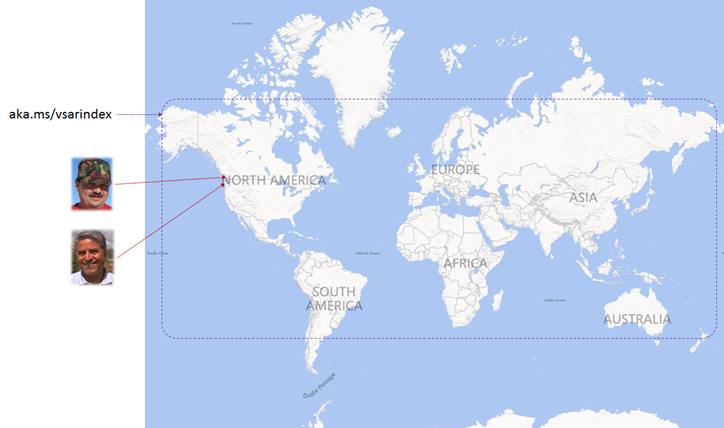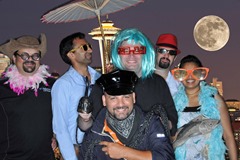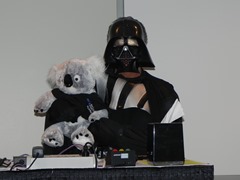Things you probably [did not] know about the Visual Studio ALM Rangers
Did you know that …
- We are 7 years old! See https://aka.ms/vsarunderstand for details.
- We specialise in distributed, part-time & very agile application lifecycle management!
- We were the first users of https://tfs.visualstudio.com! See publications for articles and journals documenting our dog-fooding and 24x365 reliance on the service … we intentionally have no fall back!
- We are here to HELP YOU! With more than 30 solutions, 16 articles, 29 videos and 200+ passionate and experienced ALM Rangers we have a wealth of real-world experience to share.
- Bijan Javidi is working out of Redmond, Willy-Peter Schaub is working further north out of the Microsoft Canada Development Centre and the 200+ Rangers team around the planet? See https://aka.ms/vsarindex for list of all ALM Rangers.

Some [in]formal processes worth (re-)discussing
We have and continue to share our processes in the Practical Ruck Guide, which evolved from geographically dispersed and virtual ALM Rangers project teams. Those familiar with the sport of Rugby will probably notice that we intentionally chose Ruck, which means “loose Scrum” in Rugby or “practitioners Scrum” in our Agile world.
Let’s take a coffee break. while I informally discuss four important topics to address a few questions we received from the Rangers and the community. For detailed information I recommend you peruse the Ruck guide and if anything is unclear, if you disagree or have any concern you should use the comment field below to start a discussion.
Project Lifecycle
- An idea is born
We collect ideas from Visual Studio UserVoice, which allows us to collaborate with the community and the product teams, and start the consolidation of numerous collections channels. We also gather ideas during discussions at events and with stakeholders, often adding them to UserVoice for transparency. - Ideas are stack-ranked
We go through all ideas on a quarterly basis, triage and publish our findings. - Project is kick-started
When we agree than an idea is important and we have a group of passionate leads and a committed product owner, we “kick-start” the project.
After defining the epics/features and agreeing on the scope, vision, objectives and deliverables, we host a kick-off meeting to share the findings and to allow all Rangers to decide whether they wish to contribute. If a Ranger feels that the project adds no value to them personally or their community they simply do not volunteer … it is important that there is a win-win for all team members and stakeholders. Some projects, for example, are a win primarily for the community, while others seem to benefit the product group. The former typically have a more mixed team, while the latter attract more of the FTE ALM Rangers … which is not a bad thing, unless a Ranger joins the wrong project for the wrong reason. - Tooling and/or Guidance
Our projects are typically of type proof of concept, tooling, guidance, or a combination thereof, with a generous sprinkle of real-world experience. The lifespan of an iteration of a project ranges from 2-4 months, sub-divided into 2-week or monthly sprints and is owned by 3-5 (optimally) / 10 (max) Rangers, supported by a Ruck Master and using our shared infrastructure, based on https://tfs.visualstudio.com. - Shipping is our favo[u]rite part
The team ships an ALPHA amongst Rangers to gather candid feedback, get candid reviews, pedantic testing and raise the quality bar before shipping a BETA silently and a RTM with lots more noise. The solutions are typically released on https://www.codeplex.com and in the case of Visual Studio extensions on the gallery. Always refer to https://aka.ms/vsarsolutions for an up-to-date map to our solutions.
Project Teams
 … a picture from a recent technical event, showing that we can also have fun
… a picture from a recent technical event, showing that we can also have fun ![]()
The personas of Rangers is outlined in the Ruck Guide. The important aspects of the project teams I would like to cover is that they consist of part-time Rangers, distributed around the planet, who volunteer their personal time, their passion for ALM and technology, and their real-world experience to deliver a solution that will ultimately benefit the community and users of Visual Studio. The Rangers are probably tired of my ramblings and constant nagging, but here we go again:
- family > job > rangers
As most Rangers have a family and a job, they often find themselves working on Ranger “stuff” in the evening or on weekends. That’s fine, but do not neglect your family as they are most important! - commit to only one project
Often Rangers stare at a triage result like my boys at a pile of wine gums. Pick one, because you cannot possibly eat them all at the same time. - no scope creep, we can do better next time
Ranger projects have bandwidth made up of un-paid, uncommitted and ad-hoc fragments of time. We need to ship what we can as soon as possible, listen to feedback from the community, recover and action the feedback in the next version. - passion fuels our team
The only reason Rangers dedicate their personal time to these projects is because they are passionate about Visual Studio, about ALM and our communities. Therefore it is imperative they join projects they are passionate about and avoid those projects they see no win-win or do not agree with. - having Hassan around is a friendly bonus
I love to have Hassan Fadili on the team, because he always has a huge for the team. A smile a day keeps the Ruck Master away!
for the team. A smile a day keeps the Ruck Master away!
Ranger Lifestyle
Every year we ask the Rangers to keep track of all their achievements such as contributions, leadership, reviews, surveys and events.
We use this information to calculate an achievement score which highlights the “best of the best”, as stated by Viper in Top Gun, issue recognition letters and scrub the dormant Rangers to make space for new associate Rangers. The achievements have a half-life of a year, which means that portions of the historical efforts are recognised going forward, often allowing Rangers to be dormant for 2+ years before being scrubbed.
Ranger States
The most important and often passionately discussed topic is the activity state of a Ranger, which we categorise as ACTIVE, INACTICE or DARK. We do not expect Rangers to be available on a 365x24 basis … remember family > job > rangers … but we expect Rangers to notify their team when they need to go inactive and to deliver what they commit to. Rangers who grab simply vanish of the radar impact their team in a negative way. They enter a DARK state and are eventually pinged by the Ruck Master or the stakeholders, especially when they committed themselves to tasks, or worse, tasks on the critical path.
| State | Action | Team | Flag raised? |
| Active | Delivering on commitments | Usually end up on champion nominations | |
| Active | Vanish | Ruck Master and Program Manager try to determine if Ranger is OK | |
| Active | Notify team of unavailability, i.e. vacation, job, illness, just-need-a-break … | Ruck Master looks for re-enforcements | |
| Inactive | Notify team of availability | Ruck Master ensures re-engagement | |
| Inactive | Vanish | Ruck Master and Program Manager try to determine if Ranger is OK | |
| Dark | Resurface | Ruck Master and Program Manager determine if re-engagement is feasible |
 In a nutshell … communication is everything to avoid the dark side!
In a nutshell … communication is everything to avoid the dark side!
Any more questions?


